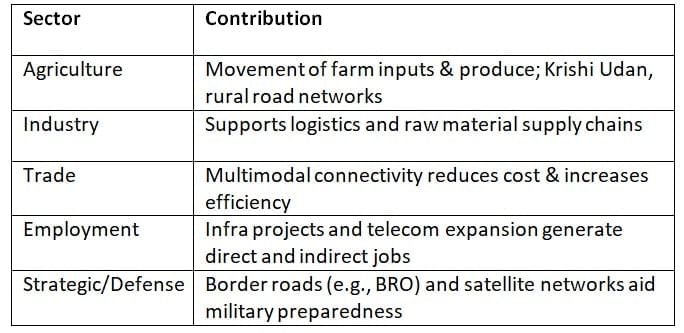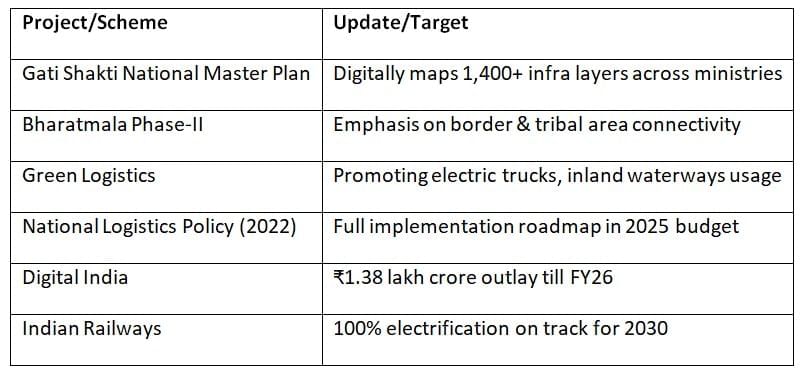UPSC Exam > UPSC Notes > Geography for UPSC CSE > Cheat Sheet: Transportation & Communication
Cheat Sheet: Transportation & Communication | Geography for UPSC CSE PDF Download
| Table of contents |

|
| Introduction |

|
| Modes of Transportation |

|
| Communication Systems |

|
| Transportation & Communication – Sectoral Impact |

|
| Major 2025 Updates |

|
Introduction
Transportation refers to the movement of people and goods, while communication involves the transmission of information. Both are lifelines of modern civilization—they promote trade, national integration, strategic defense, and overall development. As per Union Budget 2025–26, infrastructure received a significant boost, with ₹11.2 lakh crore allocated for capital expenditure—much of it going toward transportation and digital connectivity.
Modes of Transportation
Land Transport
Roadways
- India has the 2nd-largest road network in the world (over 66 lakh km as of Jan 2025).
- National Highways (NHs): ~1.47 lakh km.
Key schemes:
- Bharatmala Pariyojana Phase-II (2023–2030): ~55,000 km targeted.
- Gati Shakti Master Plan: Unified infrastructure planning.
- Expressways: Delhi-Mumbai, Bengaluru-Chennai, Ganga Expressway etc.
Railways
- Fourth-largest rail network globally, covering over 69,000 km (2025).
- Electrification: Over 85% routes electrified.
Key updates:
- Vande Bharat trains across all major routes.
- 100% electrification target by 2030.
- Dedicated Freight Corridors (Eastern & Western) operational.
- Amrit Bharat Stations scheme modernizing 1,300+ stations.
Water Transport
Inland Waterways
- Environment-friendly and cost-efficient.
- 111 National Waterways declared; NW-1 (Ganga) and NW-2 (Brahmaputra) operational.
- Jal Marg Vikas Project (JMVP): Phase-II under implementation.
Ocean Routes
- India has 13 Major Ports and ~210 Non-Major Ports.
- Handled over 1,500 million tonnes of cargo in FY 2024–25.
- Sagarmala Project:
- Boosts port-led development.
- Coastal Economic Zones (CEZs) in progress.
Air Transport
- Fastest growing aviation market (post-pandemic recovery).
- India has 160+ operational airports (2025).
UDAN (Ude Desh ka Aam Nagrik):
- Over 450 routes operationalized till early 2025.
- Focus on NE India, hill states, and tier-3 cities.
- Krishi Udan 2.0 supports air cargo for agricultural produce.
Communication Systems
Traditional Media
- India Post: Largest postal network globally; Digital India Post services expanding.
- Television & Radio: Doordarshan, AIR remain important for rural outreach.
Telecom & Digital
- Over 1.18 billion mobile subscribers (TRAI, Jan 2025).
- 5G services launched in 2023; now in 500+ cities.
- BharatNet: Aims to connect all 6 lakh villages with fiber broadband by 2025.
- Satellite Communication: INSAT, GSAT systems support weather, telecom, and disaster alerts.
- Government pushing 6G Vision Document—targeting 2030 rollout.
Transportation & Communication – Sectoral Impact

Major 2025 Updates

The document Cheat Sheet: Transportation & Communication | Geography for UPSC CSE is a part of the UPSC Course Geography for UPSC CSE.
All you need of UPSC at this link: UPSC
|
175 videos|624 docs|192 tests
|
FAQs on Cheat Sheet: Transportation & Communication - Geography for UPSC CSE
| 1. What are the primary modes of transportation and their significance in modern society? |  |
Ans. The primary modes of transportation include road, rail, air, water, and pipeline transport. Each mode has its significance:
- Road transport is vital for short distances and flexible routing.
- Rail transport is crucial for heavy goods and long-distance travel, providing efficiency and reliability.
- Air transport is the fastest option for long-distance travel and urgent deliveries.
- Water transport is cost-effective for bulk goods over long distances, especially internationally.
- Pipeline transport is essential for transporting liquids and gases over long distances.
These modes collectively contribute to economic growth, trade, and connectivity among regions.
| 2. How have communication systems evolved, and what impact do they have on transportation? |  |
Ans. Communication systems have evolved from traditional postal services to advanced digital technologies, including the internet and mobile communication. This evolution enables real-time information sharing, leading to enhanced coordination in transportation. For instance, GPS and mobile applications allow for efficient route planning, tracking shipments, and improving safety. The integration of communication systems in transportation enhances operational efficiency, reduces delays, and provides better customer service.
| 3. What is the relationship between transportation and communication, and how does it impact different sectors? |  |
Ans. Transportation and communication are interdependent; efficient transport relies on effective communication systems. This relationship impacts various sectors, including trade, tourism, and emergency services. For example, businesses can optimize supply chains through timely communication about shipment statuses. In tourism, improved communication allows for better customer engagement and travel planning. Emergency services depend on immediate communication to coordinate responses and mobilize resources effectively.
| 4. What are some major recent updates in transportation and communication sectors? |  |
Ans. Recent updates in transportation include advancements in electric and autonomous vehicles, which aim to reduce emissions and enhance safety. In communication, the rollout of 5G technology is transforming connectivity, facilitating faster data transfer and improved network reliability. These developments are expected to further integrate transportation and communication, promoting smarter cities and improving overall efficiency in logistics and personal travel.
| 5. How do transportation and communication sectors influence economic development? |  |
Ans. Transportation and communication are critical drivers of economic development. Efficient transportation systems lower costs for businesses and enhance market access, fostering trade and investment. Effective communication enables better coordination of services and information flow, which is essential for business operations. Together, they create jobs, stimulate innovation, and support the growth of new industries, ultimately contributing to a nation’s economic prosperity.
Related Searches




















